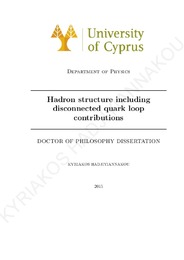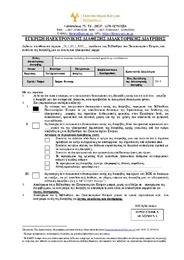| dc.contributor.advisor | Alexandrou, Constantia | en |
| dc.contributor.author | Hadjiyiannakou, Kyriakos A. | en |
| dc.coverage.spatial | Κύπρος | el |
| dc.coverage.spatial | Cyprus | en |
| dc.creator | Hadjiyiannakou, Kyriakos A. | en |
| dc.date.accessioned | 2015-08-26T09:00:55Z | |
| dc.date.accessioned | 2017-08-03T10:38:44Z | |
| dc.date.available | 2015-08-26T09:00:55Z | |
| dc.date.available | 2017-08-03T10:38:44Z | |
| dc.date.issued | 2015-05 | |
| dc.date.submitted | 2015-05-25 | |
| dc.identifier.uri | https://gnosis.library.ucy.ac.cy/handle/7/39419 | en |
| dc.description | Includes bibliography (p. 112-118). | en |
| dc.description | Number of sources in the bibliography: 137 | en |
| dc.description | Thesis (Ph. D.) -- University of Cyprus, Faculty of Pure and Applied Sciences, Department of Physics, 2015. | en |
| dc.description | The University of Cyprus Library holds the printed form of the thesis. | en |
| dc.description.abstract | Σε αυτή την εργασία μελετούμε τη συνεισφορά των ασύνδετων διαγραμμάτων κουώρκς σε αδρονικά στοιχεία πίνακα, όπως για παράδειγμα στοιχεία πίνακα τα οποία προσδιορίζουν τους παράγοντες μορφής. Οι παράγοντες μορφής αποτελούν πολύ σημαντικές ποσότητες για τη μελέτη σωματιδίων όπως το πρωτόνιο, και μπορούν τόσο να υπολογιστούν θεωρητικά όσο και να μελετηθούν πειραματικά. Σε αυτή την εργασία αναπτύσσουμε διάφορες τεχνικές υπολογισμού των ασύνδετων βρόγχων κουώρκς οι οποίοι αποτελούν ένα από τα δύο συστατικά που χρειάζομαστε για να κτίσουμε τα ασύνδετα διαγράμματα. Το άλλο συστατικό είναι οι συναρτήσεις συσχέτισης δύο σημείων. Οι ασύνδετοι βρόγχοι, σε συνδυασμό με τις συναρτήσεις συσχέτισης δύο σημείων, μας δίνουν τη δυνατότητα να υπολογίσουμε τη συνεισφορά των ασύνδετων διαγραμμάτων στις διάφορες παρατηρήσιμες ποσότητες. Μέχρι τις μέρες μας τα πλείστα αποτελέσματα από την κβαντική χρωμοδυναμική στο πλέγμα αγνοούσαν τη συνεισφορά των ασύνδετων διαγραμμάτων επειδή αναμένεται να είναι μικρή και από την άλλη επειδή ο υπολογισμός τους απαιτεί τεράστια υπολογιστική ισχύ. Με την ανάπτυξη νέων αλγορίθμων αλλά και τη συνεχή εξέλιξη των ηλεκτρονικών υπολογιστών ο υπολογισμός τους στις μέρες μας γίνεται εφικτός. Στην παρούσα εργασία εξηγούμε διάφορες στοχαστικές μεθόδους για τον υπολογισμό των ασύνδετων διαγραμμάτων. Συζητείται η μέθοδος Truncated Solver Method (TSM) η οποία μας επιτρέπει να μειώσουμε το στοχαστικό σφάλμα στα ασύνδετα διαγράμματα μειώνοντας ταυτόχρονα και το υπολογιστικό κόστος. Αυτή η μέθοδος μελετάται παράλληλα με άλλες μεθόδους όπως είναι το one-end trick, διάφορα είδη αραίωσης (dilution) αλλά και μεθόδους υπολογισμού του αντιστρόφου πίνακα χρησιμοποιώντας ανάπτυγμα ως προς την ενεργό μάζα (Hopping Parameter Expansion) για να βελτιώσουμε το σήμα. Οι μέθοδοι αυτές αξιολογούνται για 4 διαφορετικά κουάρκς (quarks) το up, το down (light) το strange και το charm. Η επιλογή της κατάλληλης μεθόδου γίνεται με κριτήριο την αποδοτικότητα της και εξαρτάται από τη μάζα των κουώρκς. Μετά από την αξιολόγηση των μεθόδων σε διάφορα παρατηρήσιμα μεγέθη, επιλέγουμε το συνδυασμό της με'θόδου TSM μαζί με το one-end trick για τον υπολογισμό μιας μεγάλης συλλογής αποτελεσμάτων τα οποία θα χρησιμοποιηθούν για να μειώσουμε σημαντικά το στοχαστικό αλλά και το στατιστικό σφάλμα προκειμένουν να εξάγουμε αξιόπιστα συμπεράσματα. Για την περίπτωση του παρατηρήσιμου μεγέθους σ-term βρίσκουμε αρκετά μεγάλη συνεισφορά από το ελαφρύ αλλά και το παράξενο κουάρκ, συνεισφορά η οποία δεν μπορεί να αγνοηθεί. Το άλλο μέγεθος στο οποίο βλέπουμε σημαντική συνεισφορά είναι το αξονικό φορτίο gΑ του νουκλεονίου. Καθαρή συνεισφορά φαίνεται και από τα δύο κουάρκς (ελαφρύ και παράξενο) αλλά το γοητευτικό έχει μηδενική συνεισφορά. Επίσης μελετούμε και την συνεισφορά στους ηλεκτρομαγνητικούς παράγοντες μορφής η οποία φαίνεται να είναι αμελητέα. Όσον αφορά το τανυστικό φορτίο gr το αποτέλεσμα δείχνει μια εξαιρετικά μικρή συνεισφορά. Μετέπειτα υπολογίζουμε και τις πρώτες ροπές των GPDs του νουκλεονίου χρησιμοποιώντας παραγώγους στον τελεστή ρεύματος. Για την ποσότητα {x)u+d παρατηρούμε μεγάλα σφάλματα και δεν μπορούμε να δώσουμε κάποια αξιόπιστη εκτίμηση. Σε αντίθεση το (x)Au+Ad παρουσιάζει μια απρόσμενα μεγάλη τιμή, αλλά χρειαζόμαστε μεγαλύτερη στατιστική προκειμένου να αποφανθούμε αν πράγματι το σήμα είναι τόσο μεγάλο. Τέλος προσπαθούμε να υπολογίσουμε την ηλεκτρική διπολική ροπή του νετρονίου χρησιμοποιώντας ασύνδετα διαγράμματα σε πρώτη τάξη ως προς την παράμετρο θ στη δράση της ΚΧΔ, που περιγράφει το σπάσιμο της συμμετρίας CP. Επίσης επεξηγούμε τον τρόπο με τον οποίο μπορεί να υπολογιστεί αυτή η ποσότητα με ασύνδετα διαγράμματα αντί της συμβατικής μεθόδου η οποία εμπλέκει το τοπολογικό φορτίο. Στο τέλος αφού έχουμε υπολογίσει την ηλεκτρική διπολική ροπή τη συνδυάζουμε με πρόσφατα πειραματικά δεδομένα για να δώσουμε μια εκτίμηση του μεγέθους της παραμέτρου θ. | el |
| dc.description.abstract | In this work we explore the contribution of disconnected diagrams in the study of hadron structure for an important class of hadronic observables, namely the form factors, which encapsulate very important information for particles like the proton and the neutron. Nucleon form factors can be measured experimentally and studied phenomenologically. In this thesis we develop techniques enabling us to calculate disconnected quark loops, which are one of the two ingredients needed in order to evaluate the disconnected part of three-point functions. Until recently most lattice QCD studies ignored the disconnected contributions either because are expected to be small or due to the enormous computational power one needs for the calculations. After the development of improved algorithms and the tremendous increase of computational power of Central Processing Units (CPUs) and Graphic Processing Units (GPUs), the calculation of disconnected diagrams has become feasible. In this thesis we study various stochastic techniques for the evaluation of disconnected diagrams. We discuss the Truncated Solver Method (TSM), which allows us to reduce the stochastic variance at reduced cost. This method is combined with other methods like the one-end trick for disconnected quark loops, various dilution schemes and the Hopping Parameter Expansion (HPE) for the expansion of the Dirac matrix in terms of the hopping matrix. The combination of all these methods will enable us to reduce the total uncertainty from the disconnected contributions. Then we assess the performance of these methods for three different masses for the light, strange and charm quark choosing the best method based on the efficiency of each one. We thoroughly assess the available methods for various observables, and employing a combination of TSM with the one-end trick and take a very large number of measurements to evaluate various observables using an ensemble of Nf = 2 + 1 + 1 twisted mass fermions (TMFs) simulated at a pion mass of 373 MeV. A number of about 150000 measurements will be used in order to reduce both the stochastic and statistical error, extracting stable and reliable results for this ensemble. For the case of the σ-term we find a large disconnected contribution from the light and strange quark sector, contributions that cannot be neglected. The disconnected contribution to the axial charge gA for the nucleon is also non-zero for both light and strange quarks, whereas the contribution due to the charm quark is compatible with zero. In addition we study disconnected contributions to the electromagnetic form factors which seem to be negligible for this pion mass. Regarding the tensor charge gT the results show a tiny contribution, which can be ignored if we compare it with the connected contribution. Moreover, we study Generalized Paxton Distributions (GPDs), which on the lattice can be computed using local operators, involving covariant derivatives. For the momentum fraction (x)u+d we observe large errors, which forbid us from giving a reliable estimate of the disconnected result. In contrast, the helicity (x)Δu+Δd shows large but noisy disconnected contributions, which requires even more statistics in order for us to draw any reliable conclusion.
Another important quantity that we study is the neutron Electric Dipole Moment (nEDM). Due to the fact that this quantity is non-zero only, if we add the (9-term in the QCD action, we expand to first order in θ. We discuss how we can use the pseudoscalar disconnected quark loops in place of the topological charge which is necessary for the computation of the nEDM. Afterwards we extract the nEDM in units of θ and use the most recent experimental result to give an upper limit to the magnitude of the CP-violating θ parameter. | en |
| dc.format.extent | ix, 118 p. : ill. (some col.), tables ; 30 cm. | en |
| dc.language.iso | eng | en |
| dc.publisher | Πανεπιστήμιο Κύπρου, Σχολή Θετικών και Εφαρμοσμένων Επιστημών / University of Cyprus, Faculty of Pure and Applied Sciences | |
| dc.rights | info:eu-repo/semantics/openAccess | en |
| dc.rights | Open Access | en |
| dc.subject.lcsh | Quarks | en |
| dc.subject.lcsh | Quantum chromodynamics | en |
| dc.subject.lcsh | Particles (Nuclear physics) | en |
| dc.subject.lcsh | Nuclear physics | en |
| dc.subject.lcsh | Electromagnetic theory | en |
| dc.subject.lcsh | Dipole moments | en |
| dc.title | Hadron structure including disconnected quark loop contributions | en |
| dc.title.alternative | Αδρονικές δομές συμπεριλαμβάνοντας συνεισφορές από ασύνδετα διαγράμματα | el |
| dc.type | info:eu-repo/semantics/doctoralThesis | en |
| dc.contributor.committeemember | Αλεξάνδρου, Κωνσταντίνα | el |
| dc.contributor.committeemember | Παναγόπουλος, Χαράλαμπος | el |
| dc.contributor.committeemember | Τούμπας, Νικόλαος | el |
| dc.contributor.committeemember | Alexandrou, Constantia | en |
| dc.contributor.committeemember | Panagopoulos, Haralambos | en |
| dc.contributor.committeemember | Toumbas, Nicolaos | en |
| dc.contributor.committeemember | Michael, Chris | en |
| dc.contributor.committeemember | Jansen, Karl | en |
| dc.contributor.department | Πανεπιστήμιο Κύπρου, Σχολή Θετικών και Εφαρμοσμένων Επιστημών, Τμήμα Φυσικής | el |
| dc.contributor.department | University of Cyprus, Faculty of Pure and Applied Sciences, Department of Physics | en |
| dc.subject.uncontrolledterm | ΑΣΥΝΔΕΤΑ ΔΙΑΓΡΑΜΜΑΤΑ | el |
| dc.subject.uncontrolledterm | ΠΑΡΑΓΟΝΤΕΣ ΜΟΡΦΗΣ | el |
| dc.subject.uncontrolledterm | ΑΣΥΝΔΕΤΟΙ ΒΡΟΓΧΟΙ | el |
| dc.subject.uncontrolledterm | ΚΒΑΝΤΙΚΗ ΧΡΩΜΟΔΥΝΑΜΙΚΗ | el |
| dc.subject.uncontrolledterm | ΚΟΥΑΡΚΣ | el |
| dc.subject.uncontrolledterm | ΝΟΥΚΛΕΟΝΙΟ | el |
| dc.subject.uncontrolledterm | ΑΞΟΝΙΚΟ ΦΟΡΤΙΟ | el |
| dc.subject.uncontrolledterm | ΗΛΕΚΤΡΙΚΗ ΔΙΠΟΛΙΚΗ ΡΟΠΗ | el |
| dc.subject.uncontrolledterm | DISCONNECTED DIAGRAMS | en |
| dc.subject.uncontrolledterm | FORM FACTORS | en |
| dc.subject.uncontrolledterm | DISCONNECTED QUARK LOOPS | en |
| dc.subject.uncontrolledterm | QUANTUM CHROMODYNAMICS | en |
| dc.subject.uncontrolledterm | QUARKS | en |
| dc.subject.uncontrolledterm | NUCLEON | en |
| dc.subject.uncontrolledterm | AXIAL CHARGE | en |
| dc.subject.uncontrolledterm | ELECTRIC DIPOLE MOMENT | en |
| dc.identifier.lc | QC793.3.Q35H33 2015 | en |
| dc.author.faculty | Σχολή Θετικών και Εφαρμοσμένων Επιστημών / Faculty of Pure and Applied Sciences | |
| dc.author.department | Τμήμα Φυσικής / Department of Physics | |
| dc.type.uhtype | Doctoral Thesis | en |
| dc.rights.embargodate | 2015-05-26 | |
| dc.contributor.orcid | Alexandrou, Constantia [0000-0001-9136-3621] | |


